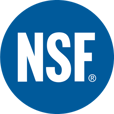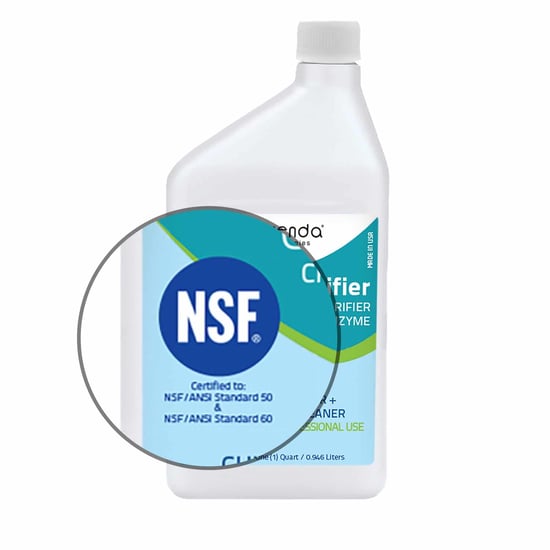NSF/ANSI Standard 50 and the MAHC

Commercial Pool Chemicals must be NSF Certified or EPA Registered
"New: Specifies that numerous pool chemicals (stabilizers, pool-grade salt, clarifiers, flocculants, defoamers, and pH adjustment chemicals) must meet either NSF/ANSI Standard 50 or NSF/ANSI Standard 60, and/or have a U.S. EPA FIFRA registration. (5.7.3)”
More from NSF.org:
 “Specifically, the code states that treatment chemicals must be certified, listed and labeled to either NSF/ANSI 50 or NSF/ANSI 60 by an ANSI-accredited certification organization, and/or have a U.S. EPA FIFRA (the Federal Insecticide, Fungicide, and Rodenticide Act) registration and be used only in accordance with the manufacturer’s instructions.”
“Specifically, the code states that treatment chemicals must be certified, listed and labeled to either NSF/ANSI 50 or NSF/ANSI 60 by an ANSI-accredited certification organization, and/or have a U.S. EPA FIFRA (the Federal Insecticide, Fungicide, and Rodenticide Act) registration and be used only in accordance with the manufacturer’s instructions.”
This is a big deal for the health and safety of commercial swimming pools.
What is the MAHC?
The Model Aquatic Health Code (MAHC) is a set of recommended standards and guidelines for the aquatics industry from the U.S. Centers for Disease Control (CDC). The MAHC is a code that can be adopted in whole or part by state or local governments, and is designed to help guide local governments in creating aquatics codes to prevent health and safety-related problems in recreational water.
The NSF, on the other hand, is a global independent organization that writes standards, tests and certifies products for the water, food, health sciences and consumer goods industries. NSF International has a committee of manufacturers, designers, scientists and other subject-matter experts who vote on what the standards should be, then the NSF goes out and tests products to see whether or not they comply with those agreed-upon standards. The MAHC just recognized that NSF-50 is a standard worth meeting to be considered safe for commercial pools.
Why have standards for pool chemicals?
Without a credible, neutral third party like NSF evaluating products for quality and safety, manufacturers could sell almost anything. For swimming pools, bathers are exposed to pool chemicals not only by accidental ingestion (swallowing some pool water), but absorption through skin. Human exposure to pool chemicals is a health and safety issue, and the MAHC recognizes that.
Our food is regulated by the FDA, and manufacturers are required to put a table of ingredients, nutritional facts and allergen information on packaging. Household chemicals are regulated by the EPA, and are required to put such certifications on their labels. The CDC is now specifying commercial swimming pool chemicals need to be held to a similar standard of quality and safety.
There are three types of certification mentioned in the new MAHC update:
Swimming pool chemicals being used in commercial pools must have at least one of those certifications. Let’s briefly cover each of these standards.
NSF/ANSI Standard 50
NSF-50 is the recreational water safety standard for equipment and chemicals. Like other standards from NSF International, the standards are created and voted on by manufacturers and experts in the industry. The NSF then tests products with intense scrutiny to see if the products meet the standard. The registered trademark NSF® mark is then put on the label of such products that meet the standard.
If a product with the NSF® mark is tested by the NSF, and it fails to meet the standard, the manufacturer is liable for penalties and can lose the NSF certification. For swimming pool chemicals, an example of this could be changing the chemical formula without telling NSF, and having the new formula tested and certified. Perhaps it could be watered down to a point where it no longer works like it is supposed to, or a harmful additive is blended in.
NSF International is a widely accepted organization that provides independent testing. It’s credibility is now recognized by the CDC. So much so, that it is on par with the EPA.

Every single Orenda product meets NSF/ANSI Standard 50.
NSF/ANSI Standard 60
NSF-60 is the drinking water safety standard for equipment and chemicals. Compared to NSF-50, NSF-60 is a more rigorous health and safety standard to meet, given that it’s for drinking water. Any chemicals or equipment used to treat drinking water must meet the NSF-60 standard. Calcium Hypochlorite is one example of a pool chemical also treats drinking water, and depending on the brand, cal hypo may already be certified to NSF-60.
EPA FIFRA Registration
Any product that claims it can kill/sanitize/disinfect anything, it must be registered with the US Environmental Protection Agency (EPA). This is required under the US Federal Insecticide, Fungicide and Rodenticide Act (FIFRA). EPA Registration is not required for speciality chemicals that do not make such claims. Products such as phosphate removers, enzymes, clarifiers, flocculants and pH adjustment chemicals do not claim to kill anything, so the EPA does not need to be involved.
If you notice, on the label of algaecide and chlorine products, there is an EPA registration number printed on it. Without that printed registration number, no ‘killing claims’ can be made.
No Orenda products have (or need) EPA FIFRA Registrations, because Orenda does not manufacture any sanitizing chemicals. We have no algaecides or any product that kills anything.
Conclusion
In commercial swimming pools, the MAHC now specifies pool treatment chemicals must be NSF/ANSI 50 or 60 certified (or EPA Registered) and appropriately labeled as such. This MAHC update encourages non-certified chemicals to either get certified, or stay out of recreational water. As we said at the beginning, this is a big deal for the health and safety of swimming pools.
Every Orenda Product is, always has been, and always will be certified to a minimum of NSF/ANSI Standard 50. To us, it’s the right thing to do, and we are pleased that the MAHC has officially recognized the importance of setting health and safety standards for pool chemicals.

